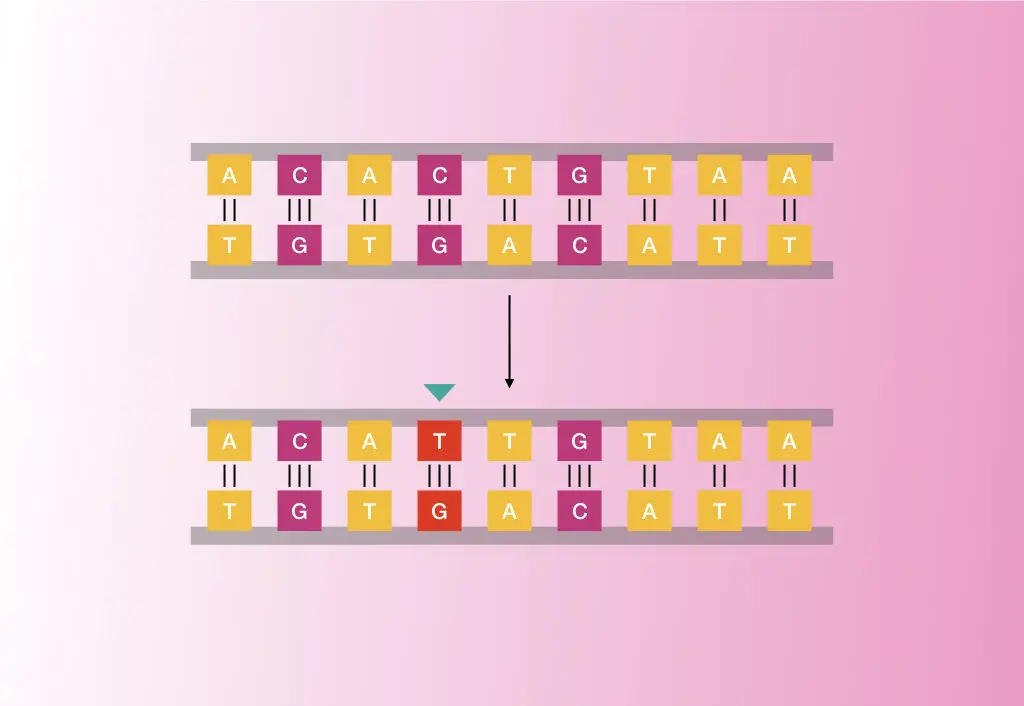“A mutation occurs at a single base on a polynucleotide DNA chain is called point mutation.”
A mutation is a natural event that changes the genetic constitution of a genome, either helpful or harmful to us.
Any alteration or change (deletion, addition or substitution) occurs in a nucleotide sequence of DNA is termed as mutation.
Read more: Different Types Of Genetic Mutations.
We have covered a lot of articles on DNA and its structure so I am not explaining it here, rather than this, I am giving you a brief overview in a few lines.
Deoxy sugar, phosphate and nitrogenous bases are the three major constituents of DNA in which nitrogenous bases are purines and pyrimidines.
Adenine and guanine are purines while thymine and cytosines are pyrimidines joined together by hydrogen bonds (three hydrogen bonds between G and C and two hydrogen bonds between A and T).
A DNA sequence is transcribed into mRNA which ultimately translated into a protein- long chain of amino acid.
A protein is made up of the polypeptide chain with different amino acid, each single amino acid is encoded by a triplet codon.
A change in the sequence of DNA disturbs the entire process. In the present article, we will discuss the common type of genetic alteration called point mutation. The content of the article is,
- What is a point mutation?
- Causes of point mutation
- Types of point mutation
- Examples of point mutation
- Detection of point mutation
- Conclusion
So let’s start,
Key Topics:
What is a point mutation?
Pictures are great self-explanatory elements, so let’s start with the picture.
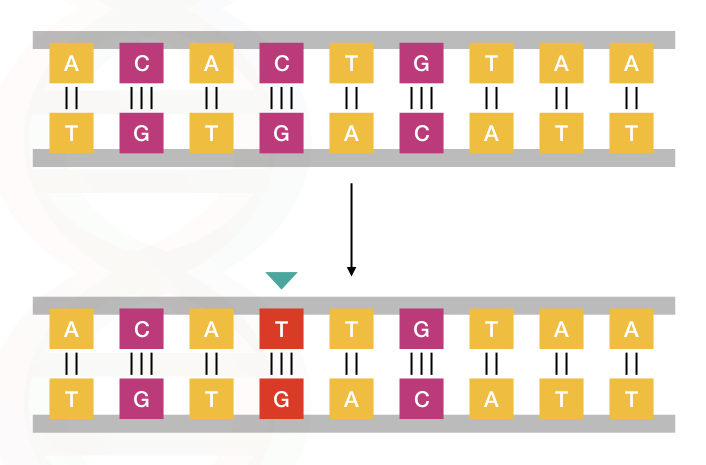
Now see the image, An alteration in a DNA sequence happens when a base or group of base, a large portion of a polynucleotide chain is deleted, inserted or inverted called mutation.
A point mutation in one of them in which at a single point a single base (A, G, T or C) is altered, however, DNA repair mechanism repairs all the point mutation in the end.
Many single point mutations occur at many sites in a DNA or gene- a function portion of DNA. If a point mutation happens in a gene, it may changes the protein encodes by it.
Conclusively we can define the point mutation as,
“A genetic mutation/ alteration caused by a single base substitution results in either non-function protein or an altered protein called point mutation.”
Silent mutation, missense mutation and nonsense mutation are three common types of point mutation reported in a gene.
Nonetheless, some scientist also considers frameshift mutation as one of them. Other two type of point mutations are transition mutations and transversion mutations.
We will understand each type of point mutation in-depth but before that let’s understand some of the causes of it.
Causes of point mutation:
The point mutation occurs at any random location in a DNA sequence, in a day, many single base substitution happens and repairs, however, some of them are pathogenic to us causes inherited genetic conditions such as sickle cell anaemia and cystic fibrosis.
The most common reason for the point mutation is an error in DNA replication.
The replication is a process in which the DNA is replicated and genetic material is doubled, with the help of the DNA polymerase different nucleotides are inserted at its complementary location to the growing DNA strand.
However, DNA polymerase sometime misses some nucleotide or insert wrong nucleotides and creates an error in replication.
Thanks to the proofreading activity of DNA polymerase. It trackback, identify the wrong insertion and repair it.
In addition to this, mutagens are also a known reason for the point mutation. A mutagen is an artificial agent that causes mutation in DNA sequence- UV light, chemicals, high heat, high-frequency light and X-rays are common mutagens reported.
Type of point mutation:
Broadly, there are many types of genetic mutations happens in a genome, however, the point mutations mainly are of three types- either addition/deletion or base substitution.
Addition or deletion:
An addition mutation occurs when a single base is inserted into a gene while a deletion mutation occurs when a single base is deleted from a gene.
The addition or deletion mutation generally results in reading frame alteration thus are mostly frameshift mutations.
Base substitution mutation:
When a single base is replaced by unlike base, the type of mutation is called base substitution mutation. It can be divided broadly into two categories.
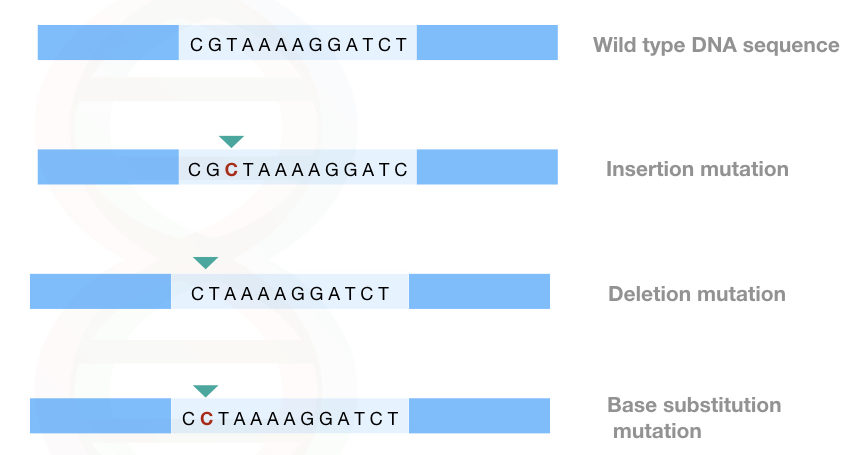
Transition vs transversion:
The transition mutation occurs when pyrimidine bases are substituted with the pyrimidine bases or purine bases are substituted with the purine bases.
The transversion mutation occurs when purine bases substitute for pyrimidine bases or vice verse.
- Purine to purine/ pyrimidine to pyrimidine = transition point mutation
- Purine to pyrimidine/ pyrimidine to purine = transversion mutation
See the image below.
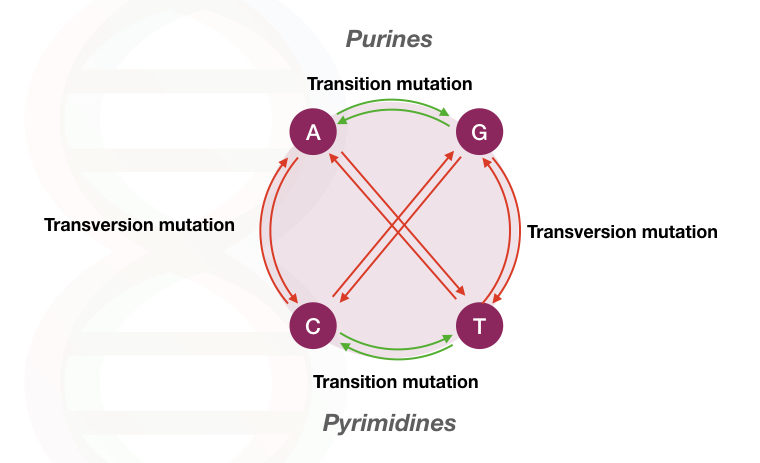
Other types of point mutation:
Silent mutation:
A silent mutation occurs when a nucleotide is replaced by another nucleotide in such a way that the same amino acid is produced anyway. Silent mutation creates new codon for the same amino acid as the native one.
For example, GAG and GAA both codes for the glutamic acid. If the G is replaced by the A in this particular codon, the same amino acid form. This type of mutation is called a silent mutation.
Missense mutation:
In the missense mutation, a different codon is formed due to nucleotide substitution, however, the different codon in not stop codon. The missense mutation results in loss of function protein or totally different protein.
In simple words we can say, the sense of protein formation is lost results in functionally different amino acid. Overall, a different protein is formed.
Nonsense mutation:
A nonsense mutation occurs when a stop codon is added instead of an amino acid coding codon.
A stop codons are a special type of triplet codon signals the end of protein synthesis, UAA, UAG and UGA are the three-stop codons ends the synthesis of protein. Likewise, the start codon starts the synthesis of protein.
The stop codon inserted at an unusual position in an amino acid sequence consequence in premature termination of amino acid synthesis or loss of functional protein. This type of mutation is called nonsense mutation.
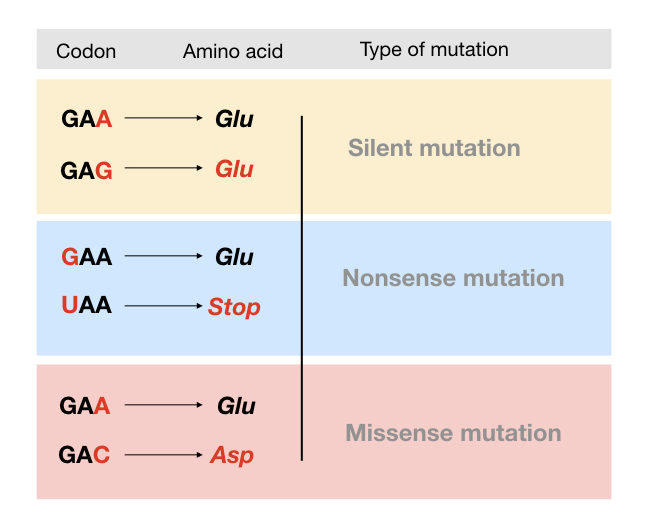
Basics:
Start codon and stop codon:
Once the mRNA transcript is formed from the DNA, the mRNA transfer to the cytoplasm and starts the process of protein synthesis.
The protein synthesis starts with the start codon AUG.
A start codon helps in starting the process of translation thus protein synthesis.
Likewise, once the process of protein synthesis completed, one of the three-stop codons (UAA, UAG, UGA) ends the process.
Some researcher believe that the frameshift mutation must be considered as a point mutation, however, some are not in favour, anyway,
A frameshift mutation occurs when an entire reading frame is altered due to the single base substitution i.e point mutation.
A reading frame is a sequence of all the codon between start codon (AUG) to stop-codon.
A point mutation (insertion or deletion) in the reading frame changes the codon within it and thus the protein synthesis altered, this type of point mutations are called frameshift mutations.
As we discussed above, the DNA polymerase has the power called proofreading activity helps in repairing any unusual changes in the gene sequence.
Sometimes it misses the sense to repair the point mutation, especially, in the germ cells and the point mutation is inherited to the progenies.
This will result in an inherited abnormal condition, for example, sickle cell anaemia, cystic fibrosis, Tay-Sachs disease and neurofibromatosis.
Related article: Genetics Basics: A Beginners Guide To Learn Genetics.
Example of point mutation:
Sickle cell anaemia:
The sickle cell anaemia is an autosomal recessive genetic disorder causes by the point mutation in the haemoglobin causing gene called Hbb gene located on chromosome 11.
A base substitution from A to T (GAG to GTG) results in conversion of valine instead of glutamic acid.
The mutant allele is known as HBS, causes disease condition in homozygous recessive condition (HBS/HBS).
An individual with the sickle cell anaemia (major) has the sickle-shaped blood cells with low oxygen-carrying capacity.
However, a carrier with a single copy of HBS remains normal but can inherit the mutant allele to consecutive generations.
The disease is more prevalent in African and Indian population.
Cystic fibrosis:
Another autosomal recessive genetic disorder is cystic fibrosis caused by the mutation in the CFTR gene.
In the CFTR gene at position 508 the entire codon CTT encodes for phenylalanine is deleted and creates the mutant CFTR allele. The mutation is called del ΔF508 results in thick and sticky mucus secretion in lungs, pancreas, intestine and other mucus-secreting glands.
We have covered an in-depth article on cystic fibrosis. Read the article here:
Besides this, neurofibromatosis, Tay-Sachs disease and colour blindness are some of the other examples of point mutation.
Cancer:
The point mutations are commonly involved in the inactivation of the tumour suppressor genes. The tumour suppressor genes mainly help in the cell division and cell growth, insertion/deletion or base substitution mutation results in conversion of proto-oncogene into oncogenes and thus cancer.
The point mutation either abort protein synthesis or increase the protein function, in either way it causes abnormal cell growth- cancer.
Detection of point mutation:
A point mutation is often termed as single nucleotide polymorphism detected using either though polymerase chain reaction or DNA sequencing. However, some markers alike RFLP can also be used for some.
A single nucleotide polymorphism is an alteration at a single base either helpful or harmful, produces different alleles for a gene.
Using the sequence-specific primers for different alleles, an allelic variation can be detected using PCR.
For example, a point mutation of a sickle cell can be encountered using two different sets of primers- one for normal allele and one for the mutant allele, the method is often known as allele-specific PCR.
You can read our article on it: Allele-specific PCR
Another method for detecting single base variation is DNA sequencing. In which any known or unknown point mutation is detected.
Using the fluorescent dye, the sequence of DNA read in the machine and compared with the reference sequence for detection of variation.
Related article:
Conclusion:
A point mutation is a single base mutation, frequently observed throughout the genome but their pathogenicity is rarely observed. However, some cause cancer or inherited genetic disorders.
The proofreading activity of DNA polymerase helps in repairing the nucleotide changes. Nonetheless, not all the point mutations can be repaired.
Using the state of the art molecular genetic techniques a point mutation or group of point mutations can be detected.
Sources:
- Point mutation by biology dictionary.
- Frenette PS, Atweh GF. Sickle cell disease: old discoveries, new concepts, and future promise. J Clin Invest. 2007;117(4):850–858. DOI:10.1172/JCI30920.
- Naehrig S, Chao CM, Naehrlich L. Cystic Fibrosis. Dtsch Arztebl Int. 2017;114(33-34):564–574. Doi:10.3238/arztebl.2017.0564.
